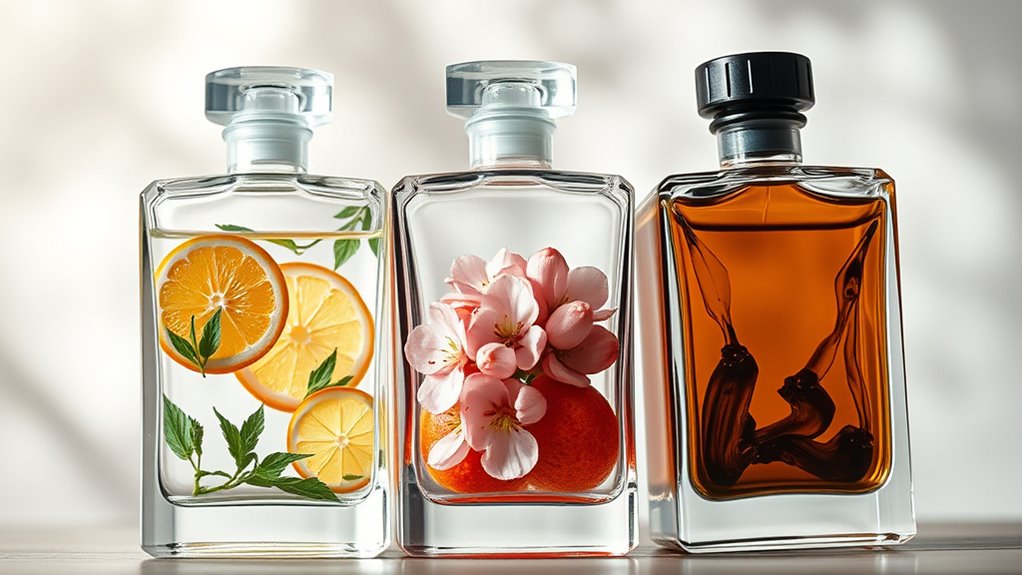Understanding fragrance notes—top, heart, and base—helps you grasp how perfumes evolve and last longer. When you spray a perfume, the top notes are the first scents you notice, which fade quickly. The heart notes emerge afterward, giving the perfume its main character. Finally, base notes develop deeply and linger, providing warmth and longevity. Exploring these layers allows you to create personalized scent experiences; keep going to discover how each layer works together for the perfect fragrance.
Key Takeaways
- Perfumes consist of three main layers: top, heart, and base notes, each contributing to the scent’s development.
- Top notes are light, fresh, and immediate, forming the first impression of the fragrance.
- Heart notes develop after the top notes fade, providing the main character and complexity of the scent.
- Base notes are deep, warm, and long-lasting, anchoring the fragrance and enhancing longevity.
- Combining these notes through layering creates a personalized scent profile and extends the perfume’s wear time.

Have you ever wondered what gives a perfume its distinctive scent? It all comes down to fragrance notes, which are the different layers that make up a perfume’s aroma. Understanding these notes can help you appreciate how scents evolve over time and how to maximize their impact. One key aspect to consider is fragrance layering, which involves combining different notes to create a unique and personalized scent profile. When done right, this technique not only enhances your overall fragrance experience but also improves scent longevity, ensuring your perfume stays vibrant longer throughout the day.
Perfumes are typically structured in three main layers: top, heart, and base notes. The top notes are what you smell immediately after applying the perfume. They’re usually light, fresh, and fleeting, lasting only a few minutes before giving way to the next layer. These initial impressions are vital—they set the tone for the entire scent and influence your first impression. If you’re aiming for a longer-lasting fragrance, choosing a perfume with well-balanced top notes can help you kick off your day with a burst of freshness that’s inviting but doesn’t fade too quickly.
As the top notes fade, the heart notes emerge. These form the core of the perfume and tend to be more complex and enduring than the top notes. They can last several hours and are often floral, fruity, or spicy, providing the main character of the scent. When you’re exploring different fragrances, pay attention to how the heart notes develop over time, as this is where your perfume truly starts to express its personality. Combining your perfume with complementary scents through fragrance layering can enhance the shift from top to heart, making the overall experience richer and more persistent.
Finally, the base notes are the foundation of the fragrance. They are deep, warm, and lasting, often lingering for many hours after the initial application. These notes include ingredients like musk, amber, or woody accords that anchor the scent and provide depth. To maximize scent longevity, choose perfumes with robust base notes or consider layering with other products that contain similar base accords. This technique helps your scent stay strong and vibrant longer, even as the lighter top and heart notes fade away.
Frequently Asked Questions
How Do Fragrance Notes Change Over Time During Wear?
As you wear a fragrance, the scent evolves through layering techniques that reveal different notes over time. Initially, the top notes dominate, giving an immediate impression. As these fade, the heart notes emerge, creating the core of the scent. Eventually, the base notes become prominent, providing fragrance longevity and depth. Understanding this progression helps you appreciate how your scent transforms, allowing you to optimize application for a lasting, balanced aroma throughout the day.
Can Fragrance Notes Influence Mood or Emotions?
Like a painter’s palette, your scent perception influences your emotions and mood. Fragrance notes act as emotional triggers, awakening feelings and memories. A fresh citrus top note can energize, while a warm vanilla base soothes and comforts. When you wear a scent, it can subtly shape your feelings, turning your mood into an intricate dance of scent and emotion, making every moment more vivid and memorable.
Are There Specific Notes Suited for Different Seasons?
Yes, you should choose fragrance notes based on seasons. During spring and summer, floral notes align with seasonal scent trends, evoking freshness and lightness. In fall and winter, spicy notes create warmth and coziness. You’ll find floral scents more suited for warmer months, while spicy notes are perfect for colder weather. This seasonal approach helps you enjoy your fragrance’s mood-enhancing qualities year-round.
How Do Perfumers Select and Blend Fragrance Notes?
You wonder how perfumers select and blend fragrance notes? They use expert blending techniques, carefully balancing the note hierarchy to create harmony. First, they choose the top notes to grab your attention, then layer the heart notes to develop the scent’s character, and finally anchor it with base notes for depth. This precise process builds anticipation, revealing a complex, enthralling fragrance that evolves beautifully over time.
Do Fragrance Notes Vary by Cultural Preferences?
Yes, fragrance notes do vary by cultural preferences. You’ll find regional scent trends influence which notes are popular, as different cultures favor certain aromas. For example, some regions prefer floral and citrus notes, while others lean toward spicy or woody scents. When selecting or blending fragrances, you should consider these cultural fragrance preferences to create scents that resonate with local consumers and match regional tastes effectively.
Conclusion
Now that you understand the layers of fragrance notes—top, heart, and base—you can better appreciate how perfumes unfold over time. Some believe that a well-balanced scent reflects your personality, with each note revealing a different facet. While not scientifically proven, this theory paints a vivid picture: your fragrance becomes a personal story, evolving uniquely with you. So, choose your notes thoughtfully, and let your scent tell your story effortlessly.









